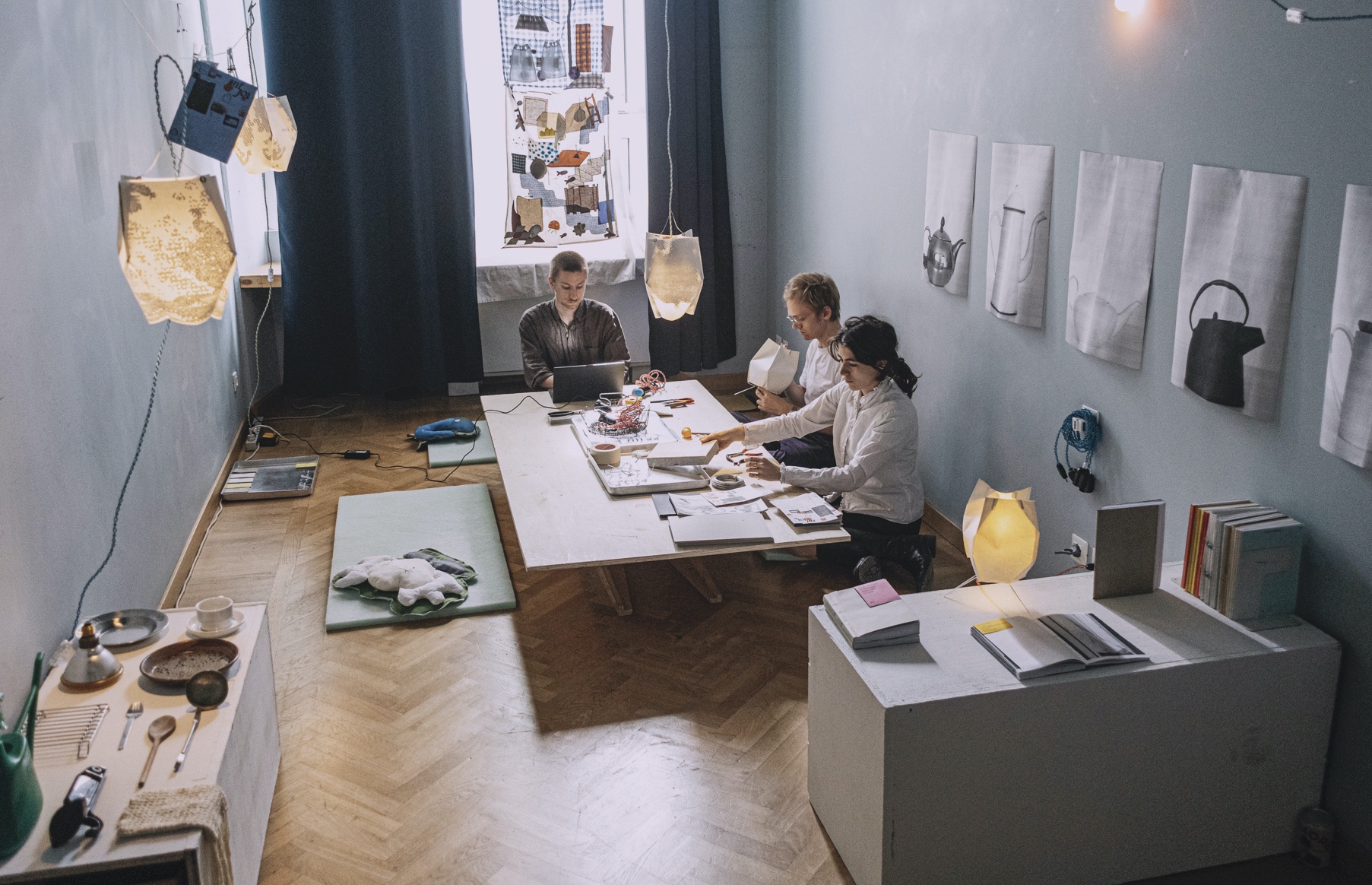Edith is a group project by the people who live in our house and the people who visit often. Starting from the place we live, cradled by an everyday intimate domesticity, Edith sets out equipped with its materiel to test ways of thinking, communicating, and making.
now
Talking from a kite, Residency at Vaisseau Mère, Brussels, October–December 2025

Edith clocks into the factory, constructed in the era of heavy industry. Playing with gravity rather than battling it, Edith takes flight.
From editions to flip through, to objects to touch, we progress to structures big enough to surround us. Edith undertakes research on the kite with the intention of deploying it in this confined space. We develop techniques to generate and capture the force of the wind, through both mechanical means and the movement of the body.
Examining at once flying devices and the forces that propel them, inquiry into each subject informs understanding of the other. This allows for a generative cycle of discovery and construction.
How can we collectively deploy a technical and symbolic order? What are the resulting forms, and how will they move? A sign inscribed in the sky, the ground untouched, a lightweight and mobile architectural exercise, a medium to project from above — a bird’s eye view.
Perle Venzal, Nathan Raccah, Louise Dousset, Clara Nop, Tchoutchou Tophoven, Xander Maclaren.
past
Front of house, Brussels, March 2025
Back home, Edith empties its living room. Declaring this a spare room, we convene to assemble the artefacts of each of our practices, arranging them in this space defamiliarized by the installation of pseudoarchitectural cardboard columns wedged between floor and ceiling:
Papier-mâché farm animals plus cat; magnets ringing in time on amplified guitar strings; a carved stone seal and the impression it makes; flowers in the forms of extension cords and crochet amulets; notebooks pressed open against the wall; angels drawn and stuffed; a whole other house seen though DS screens; a television blocking the passage to the rest of our house while showing what might be going on back there. All the while, the soup bubbles away in the chimney.
Xander Maclaren, Louise Dousset, Perle Venzal, Clara Nop, Léna Yumie Trullier, Tchoutchou Tophoven, Ward Lauwers, Mathieu Beaucarne, Nathan Raccah.
Edith editions, Fanzines festival, Brussels, December 2024
In a corner of the old brasserie, the printers from our dining room shelf — Kyocera laser, Epson large format dot-matrix — huddle with us around a circular table on castors covered in booklets, travelogues, sketches of imagined films, calendars, printed ephemera, secret pouches, and paper lamps — signed Edith, maison d’édition.
Louise Dousset, Perle Venzal, Nathan Raccah, Ward Lauwers, Xander Maclaren, Léna Yumie Trullier, Clara Nop, Mathieu Beaucarne.
Photo by Ward Lauwers
Angeli’s the light, residency at BASE, Milan design week, April 2024

An Italian hotel room, stripped of its comforts, fills up with strangers’ faces, trays of off-spec paperclips, hardware store back-aisle merchandise restlessly rearranged, and most of all stacks of printed paper — coloured by the odd tones of painted lightbulbs and patterned by the shadows of innumerable hanging bits of things. When we aren’t sitting working at our low table, we see Milan design week armed with the badges around our necks, advised by our mission statement:
Angeli’s the Light
Four years of attempts to find a good life in industrial Eindhoven, the city of light: the exotic in the ultralocal, the entanglement of house and factory, the intimate and the rational. Energy spent avoiding isolation.
After school we moved together to Brussels, in a house on avenue Montjoie owned by minor Flemish nobility. Across from a small park and down the street from a large one. Solidly built in the first half of the twentieth century without us in mind.
We adapt it to our purposes as we search and work, balancing between burn-out and bore-out, figuring out what to do in a world of infinite urgencies where individual happiness seems always to lean on the exhaustion of countless others.
We bring with us through the Brenner Pass fragments of stories of friendship, dinners, bricolage, 400 coups; from Eindhoven to Brussels and from Brussels to Milan. Temporary solutions that have become permanent and specific findings that could be useful elsewhere.
We’re equipped with enough to build, cook, and publish. We hope to reach the promised hotel room, soon to be nested, cluttered, made soft and porous to the industrial and domestic legacy of the town.
Melancholia, sprezzatura haunting the streets, vodka and bitterness after lunch, Mastroianni fixing a lamp, the 24/7 Carrefour midnight worker, isolated 1 euro cafes, banana boxes and flea markets, the city’s answer to the question of how to live a good life.
Nathan Raccah, Louise Dousset, Xander Maclaren, Perle Venzal.
Photo by Cartacarbone
prehistoric
Websites of ancestor projects to Edith:
















